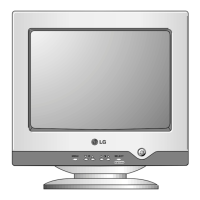
Do you have a question about the LG Flatron T710P and is the answer not in the manual?
CRT physical and electrical characteristics like size and deflection angle.
Video input signal types and sync specifications.
Input voltage range and power consumption details.
Active video area dimensions and resolution capabilities.
Operating temperature, humidity, and altitude limits.
Physical size measurements including height, width, and depth.
Net and gross weight specifications.
Critical safety parts and replacement guidelines.
Servicing safety procedures for high voltage areas.
Precautions against electrical shock and fire risks.
CRT implosion protection system and handling.
X-radiation sources and prevention measures.
Standard procedures to follow before and during monitor servicing.
Handling sensitive components to prevent static discharge damage.
Steps for removing and replacing integrated circuits.
Procedures for replacing transistors.
Instructions for removing and installing diodes.
Steps for replacing fuses and resistors.
Repairing copper traces at IC connections.
Repairing copper trace breaks at non-IC points.
Guide for removing monitor back cover and tilt/swivel.
Power supply unit operation.
Circuit for protection against excessive voltage.
Details on power saving modes.
Microprocessor role in sync processing.
Circuit for regulating DC voltage for FBT.
Circuit to shut down HV in case of X-radiation abnormality.
Circuit for correcting horizontal linearity.
Amplifier for horizontal deflection.
Automatic Beam Limiter circuit for CRT reliability.
Circuit driving the vertical deflection yoke.
Circuits for retrace line elimination and brightness.
Circuit for correcting screen tilt.
Circuit for displaying monitor status.
Video drive output and gain control.
Amplifies analog video signals.
Amplifies video signals for CRT.
Tools and general information for performing adjustments.
Accessing and using the service hot key menu.
Parameters for Focus, Size, and Centering.
Steps for B+ voltage and high-voltage adjustments.
Procedure for adjusting geometric distortion.
Steps for adjusting horizontal and vertical linearity.
Procedures for adjusting luminance and regulation.
Method for correcting trapezoidal distortion.
Steps for balancing pin convergence.
Procedure for correcting parallelogram distortion.
Steps for adjusting white balance and chromaticity.
Procedure for adjusting black level and cut-off point.
Steps to adjust focus VR for image sharpness.
Procedures for correcting color purity issues.
Using PC software for adjustments.
Guide for reading, modifying, and saving EDID data.
Procedure for writing EDID data to EEPROM.
Steps for when the monitor does not turn on.
Steps for when no image or characters are displayed.
Steps for when the screen remains blank.
Steps to fix vertical image display issues.
Troubleshooting for Display Power Management failures.
Troubleshooting for degaussing circuit issues.
Steps to fix horizontal deflection problems.
Troubleshooting for fixed horizontal size issues.
Steps to fix horizontal linearity problems.
Troubleshooting for incorrect horizontal image size.
Diagnosing issues with side pin or trap components.
Troubleshooting for screen tilt issues.
Diagnosing vertical size or position variations.
Troubleshooting for high voltage related problems.
Diagnosing Automatic Beam Limiter circuit failures.
Troubleshooting for image focus problems.
Troubleshooting for microcontroller issues.
Diagnosing On-Screen Display malfunctions.
Troubleshooting for monitor control button issues.
Steps to diagnose and fix color display problems.
Troubleshooting for visible retrace lines.
Steps to diagnose and fix color purity problems.
Troubleshooting for image misalignment.
Steps to diagnose and fix poor image focus.
